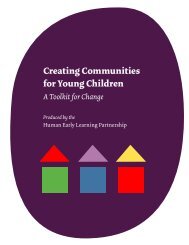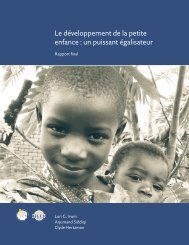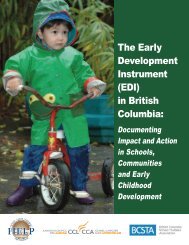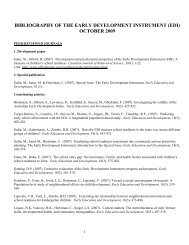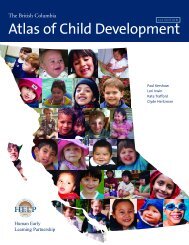Total Environment Assessment Model for Early Child Development
Total Environment Assessment Model for Early Child Development
Total Environment Assessment Model for Early Child Development
You also want an ePaper? Increase the reach of your titles
YUMPU automatically turns print PDFs into web optimized ePapers that Google loves.
<strong>Total</strong> <strong>Environment</strong> <strong>Assessment</strong> <strong>Model</strong><br />
<strong>for</strong> <strong>Early</strong> <strong>Child</strong> <strong>Development</strong><br />
Map Created by Eric Hertzman<br />
using spatial data from ESRI, and CFC<br />
data from the <strong>Child</strong> Friendly Cities Initiative<br />
Innocenti Web Site. 2006-12-20<br />
figure 5: child friendly cities<br />
and priorities (Guerra, 2002). This initiative<br />
was part of a broad vision developed by<br />
council to: promote and institutionalize the<br />
participation of children and youth in the<br />
management of their city; to encourage their<br />
civic engagement; and to help them recognize<br />
the importance of their role as citizens<br />
(Guerra, 2002).<br />
Each year since its commencement, more<br />
than 6,000 children have taken part in<br />
discussions and assemblies to elect their child<br />
councilors and share their opinions regarding<br />
civic priorities. In addition to participating<br />
in the planning and developments that take<br />
place in Barra Mansa, the children’s council<br />
has us $125,000 <strong>for</strong> use on priorities and<br />
initiatives decided by the council. Examples<br />
of some projects funded from this budget<br />
are: repairs to schools and school equipment,<br />
improvements to play-grounds in low income<br />
areas, repairs to sewers and drains and tree<br />
planting within the city (Guerra, 2002).<br />
occupied palestinian territory<br />
cfcis are taking place in four locations<br />
within the Occupied Palestinian Territory—<br />
two in the Gaza Strip (Rafah and Gaza City)<br />
and two in the West Bank (Jenin and Jericho).<br />
This initiative started as a pilot project<br />
in 1996 to help communities living in<br />
densely populated areas under incredibly<br />
challenging conditions (Riggio, 2002). Its<br />
objective, as stated in a cfc report, was: “to<br />
support decentralization processes, promote<br />
community participation and translate the<br />
principles of the Convention on the Rights<br />
of the <strong>Child</strong> into the daily lives of children,<br />
families and communities (Riggio, 2002).”<br />
Out of this pilot project fifteen ‘<strong>Child</strong>ren<br />
Activity Centres’ were created <strong>for</strong> children<br />
to participate in educational and recreational<br />
activities that were lead by youth leaders<br />
(Riggio, 2002).<br />
Currently the focus of the cfci in the<br />
Occupied Palestinian Territories is to protect<br />
the rights of children more directly exposed<br />
to the armed conflict. In each of the four<br />
locations mentioned above a ‘dual-approach’<br />
to planning has been implemented—first to<br />
identify and respond to present emergency<br />
needs and second to encourage more comprehensive<br />
protection strategies <strong>for</strong> children<br />
(unicef Occupied Palestinian Territory,<br />
2003). As a result of this cfci, ‘Safe Play<br />
Areas’ have been developed to limit children’s<br />
exposure to violence and increase children’s<br />
participation in positive and health-promot-<br />
45



